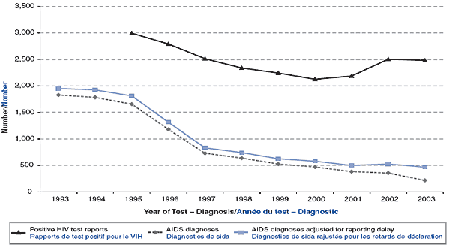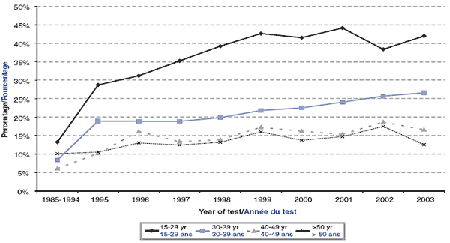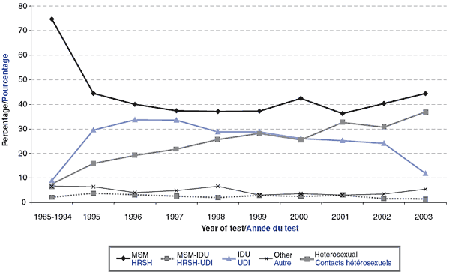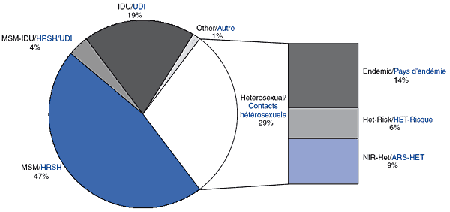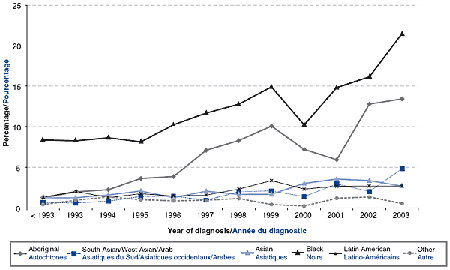Common menu bar links
Institutional links
Diseases & Conditions
Health & Safety
Research & Statistics
Agency Information
Search Box
E-mail this page
HIV and Aids in Canada
Surveillance Report to December 31, 2003
April 2004
Surveillance and Risk Assessment Division
Centre for Infectious Disease Prevention and Control
Population and Public Health Branch
HIV and AIDS in
Canada - Surveillance Report to December 31,
2003
83 Pages - (458 KB) 
ISSN 1488-1926 - (On-line) ISSN 1701-4166
Acknowledgements: National level HIV and AIDS surveillance is possible as a result of all provinces and territories participating in, and setting directions for, HIV and AIDS surveillance. Accordingly, the Centre for Infectious Disease Prevention and Control acknowledges the provincial/territorial HIV/ AIDS coordinators, laboratories, health care providers and reporting physicians for providing the non-nominal confidential data that enable this report to be published. Without their close collaboration and participation in HIV and AIDS surveillance, the publication of this report would not have been possible. A complete listing of these contributors is available in Appendix 5.
We also thank Scientific Publication and Multimedia Services, Population and Public Health Branch, for its contribution in editing and producing the report, both in print and on the internet..
N.B. This document must be cited as the source for any information extracted and used from it.
Suggested citation: Health Canada. HIV and AIDS in Canada. Surveillance Report to December 31, 2003.
Information to the readers of HIV and AIDS in Canada
On behalf of the HIV/AIDS Surveillance Section, I would like to present you with the HIV and AIDS in Canada: Surveillance Report to December 31, 2003. This report is part of a semi-annual series providing a review of available HIV and AIDS surveillance data in Canada.
The HIV/AIDS Surveillance section is part of the Surveillance and Risk Assessment Division, at the Centre for Infectious Disease Prevention and Control. This section is responsible for data collection and management, analysis and report production. In addition, we continue to improve data quality, define and set surveillance standards, as well as support the use of these data to influence programmatic and policy action.
The main findings of the surveillance data are outlined in the section entitled At a Glance, and this is followed by a series of tables summarizing the underlying data. Technical notes, in addition to references and data sources, are available in the Appendices. Explanatory details specific to provincial or territorial surveillance data issues are located at the beginning of each section.
A further description of HIV and AIDS surveillance data is available in the HIV/AIDS Epi Updates reports that are also available on our website listed on the front cover of this report.
The publication of this report would not be possible without the submission of HIV and AIDS surveillance data from all provinces and territories. Their ongoing contribution to national HIV and AIDS surveillance is gratefully acknowledged and is further listed in Appendix 5.
Yours sincerely,
Jennifer Geduld, MHSc Manager
HIV/AIDS Surveillance Section
Surveillance and Risk Assessment Division
Table of Contents
At a Glance
Introduction
The following report outlines HIV and AIDS surveillance data providing a description of persons who have been diagnosed with HIV and AIDS in Canada. Surveillance data understate the magnitude of the HIV epidemic and consequently does not represent the number of people infected with HIV (prevalence) or the number infected each year (incidence). Some of the reasons for this include the fact that surveillance data are subject to delays in reporting, underreporting and changing patterns in HIV testing behaviours (who comes forward for testing). In addition, surveillance data can only tell us about persons who have been tested and diagnosed with HIV or AIDS and not those who remain untested and undiagnosed. Furthermore, because HIV is a chronic infection with a long latent period, many persons who are newly infected in a given year may not be diagnosed until later years.
The Centre for Infectious Disease Prevention and Control (CIDPC)
has recently produced estimates of HIV prevalence to the end of
2002 and HIV incidence in 20021. These estimates were
produced using a combination of methods, incorporating data from a
wide variety of sources, including HIV test reports, AIDS case
reports, population-based surveys, targeted epidemiological studies
and census data. It was estimated that at the end of 2002 there
were approximately 56,000 (46,000-66,000) people in Canada living
with HIV (including those living with AIDS), of which approximately
one third were undiagnosed. The number of people in Canada newly
infected with HIV in 2002 was estimated to be 2,800-5,200.

HIV Surveillance Data
There have been 55,180 positive HIV tests reported to CIDPC since HIV testing began in 1985. The annual number has declined from 2,996 in 1995 to 2,187 in 2001 and has since increased to 2,504 in 2002 and 2,482 in 2003 (Figure 1). The increase in the number of positive HIV test reports in the last two years may be partly attributed to recent changes in immigration policies at Citizenship and Immigration Canada2. These changes have included the addition of HIV screening to the routine immigration medical assessment in January 2002 and reduced restrictions on certain groups of immigrants who would have previously been considered medically inadmissible associated with changes to the definition of some applicant groups. In most provinces and territories, for the HIV screening conducted in Canada, the positive HIV test reports are handled in the same manner as all other positive HIV and are included in provincial/ territorial HIV reporting to CIDPC.
1 Geduld J, Gatali M, Remis RS, Archibald CP. Estimates of HIV prevalence and incidence in Canada, 2002. Can Commun Dis Rep, 2003;29:197-206.
2 Citizenship and Immigration Canada. Immigrant and Refugee Protection Act. Statutes of Canada 2001. Chapter 27. Also available at url: http://www.cic.gc.ca/english/pdf/pub/C-11_4.pdf or url: http://www.ci.gc.ca/cicexplore/english/org/bpd/bps/irpa_lipr/act_loi/C-11_4.pdf
FIGURE 1
Positive HIV test reports and AIDS diagnoses by year of diagnosis,
1993-2003
Females are representing a growing proportion of positive HIV test reports. For the last three years females have accounted for around one quarter of positive HIV test reports with known gender, this is a rise from 8.9% during the period between 1985 to 1992 (Table 3). This pattern is seen in all age groups and most notably in the 15-29 and 30-39 year age group as seen in Figure 2.
FIGURE 2
Proportion of females among positive HIV test reports by age
group
As outlined in Figure 3, men who have sex with men (MSM) continue to account for the largest number and proportion of positive HIV test reports. This proportion decreased from close to 75% between 1985-1994 dropping in the mid to late 1990's remaining close to 37% until a slight increase in the last three years to 44.4%. The diverse heterosexual exposure category has steadily increased from 7.5% before 1995 to 36.9% in 2003. This exposure category is made up of three subcategories including heterosexual contact with a person who is either HIV-infected or at increased risk for HIV, heterosexual as the only identified risk, or origin in a country where HIV is endemic. Over the last five years, from 1998 to 2003, the proportion of positive HIV test reports attributed to the latter heterosexual subcategory has increased from 2.9% to 10.2%. Further details of the trends in the heterosexual subcategories for the last five years are outlined in Figure 4.
FIGURE 3
Positive HIV test reports by exposure category and year of
test
MSM: men who have sex with men; IDU: injecting drug users;
Endemic: born in a country where HIV is endemic; Het-Risk:
heterosexual contact with a person who is either HIV-infected or at
increased risk for HIV; NIR-Het heterosexual as the only identified
risk; Other: recipients of blood transfusion or clotting factor and
occupational transmission.
Percentages are based on total number minus reports for which risk
was not reported.
FIGURE 4
Positive HIV test reports among heterosexual transmission by sub
category, 1998-2003
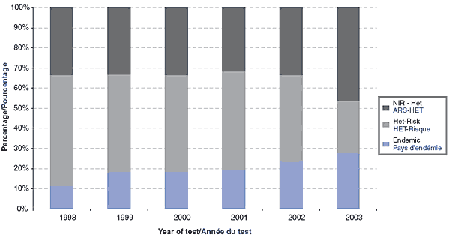
Het-Risk: heterosexual contact with a person who is either HIV-infected or at increased risk for HIV; Endemic: born in a country where HIV is endemic; NIR-Het heterosexual as the only identified risk
AIDS Surveillance
There have been a cumulative 19,344 AIDS diagnoses in Canada reported to the CIDPC up to the end of 2003. The annual number of reported AIDS diagnoses adjusted for reporting delay increased throughout the 1980's and early 1990's, peaking at 1,953 in 1993 and has since declined and has started to level off to 500-600 diagnoses per year (Figure 1, Table 11). This pattern of declining AIDS diagnoses has been reported in other industrialized areas including the United States, Australia, and the United Kingdom. The decline has been largely attributed to the widespread use of highly effective antiretroviral therapy since 1996, however, there is a growing concern that reporting of AIDS diagnoses are becoming increasingly under reported.
The largest proportion of reported AIDS cases are among those aged 30-44 years followed by the 45-59 and 15-29 year age groups accounting for 60.4%, 19.4% and 15.9% of all AIDS diagnoses respectively. Adult females are increasingly representing a larger proportion of diagnosed AIDS cases. Over the last 10 years this proportion has increased from 7.0% in 1993 to 24.2% in 2003 (among AIDS diagnoses with reported age and gender). In 2003, females represented 42% of AIDS diagnoses among those aged 15-29 years, 25.4% among those aged 30-44 years and 18.2% among 45-59 year olds.
Over the last decade, there has been a decrease in the
proportion of reported AIDS cases among men who have sex with men
(MSM) falling from 73.8% in 1993 to 35.3% in 2003. Conversely, the
diverse heterosexual exposure category has shown an increase in
this proportion, from 13% in 1993 to 43.8% in 2003 during this same
period. The distribution of exposure categories for the last five
years can be seen in Figure 5. 
FIGURE 5
Reported AIDS diagnoses by exposure
category,1999-2003
MSM: men who have sex with men; IDU:
injecting drug users; Endemic: born in a country where HIV is
endemic; Het-Risk: heterosexual contact with a person who is either
HIV-infected or at increased risk for HIV; NIR-Het heterosexual as
the only identified risk; Other: recipients of blood transfusion or
clotting factor and occupational transmission
Percentages are based on total number minus reports for which risk
was not reported
The proportion of reported AIDS cases attributed to White Canadians has been decreasing over time, from 86.8% prior to 1993 to 54.3% in 2003. This decrease is coupled with increases seen in among both Black and Aboriginal Canadians as outlined in Figure 6 and Table 18. Black Canadians represented 8.4% of cases before 1993 and 21.5% in 2003; during the same period this proportion increased from 1.2% to 13.4% among Aboriginal Canadians.
FIGURE 6
Non-White Ethnic categories as a percentage of all reported
AIDS diagnoses, by year of diagnosis (all ages)
Interpretation
The increasing proportion of both positive HIV test reports and AIDS diagnoses attributed to the heterosexual exposure category and the distribution in its subcategories is a trend that will be followed and further analyzed in the upcoming months. The rising proportion of positive HIV test reports among Aboriginal and Black Canadians as well as among females in each age group, especially in the younger years, is an important finding that has implications for guiding prevention and treatment programs.

